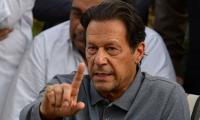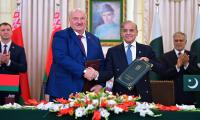There are many similarities between the economic situation that India faced in the early 1990s and the one Pakistan currently faces. Last year, I wrote a series of articles that covered the first 40 years of post-independence India. The last part of that series appeared on these pages on December 5, 2022.
Resuming that discussion may prove to be instructive for observers and students of history and politics of India. The 1990s introduced multiple significant factors in India related to caste, politics, economic crisis – that led to liberalization – the emergence of coalition governments, and the resurgence of regional and religious parties as major players at the federal level.
General elections in 1989 in India brought VP Singh to power as prime minister, but he could only last for less than a year. Though the Congress was the largest party with 197 seats and nearly 40 per cent of the total votes cast, the Janata Dal (JD) and the Bharatiya Janata Party (BJP) obtained 143 and 85 seats respectively.
It is worth recalling that the BJP won only two seats in the 1984 elections. But within five years, it scored a major improvement by fanning Hindu fundamentalism, possibly as a reaction to General Zia’s fundamentalist policies in Pakistan for over a decade.
Another factor for the gains of the BJP was an understanding between the BJP and the JD that they would not contest against each other on most seats, wherever possible. They facilitated the unity of the anti-Congress vote and helped the BJP emerge as a strong party with 85 MPs.
It is also interesting to note that in 1989, the Communist Party of India (CPI) and the Communist Party of India – Marxist (CPI-M) won 45 seats: CPI-M, 33 and CPI, 12. These left-wing parties emerged as the third largest force in the lower house of the Lok Sabha (the Indian parliament). At least 265 MPs were needed to form the government, but Rajiv Gandhi made it clear that the Congress was not interested in it. The BJP and the left parties announced their outside support for a National Front (NF) government. This was the second non-Congressional alliance that came to power nearly 10 years after the collapse of the first non-Congressional government in 1979 under the Janata Party.
The president of the National Front was Andhra Pradesh leader NT Rama Rao, and the NF included the Janata Dal of VP Singh and five other parties. There were three prime ministerial candidates: Chandrasekhar and VP Singh from UP, and Devi Lal from Haryana. Ultimately VP Singh became PM and appointed Devi Lal as his deputy prime minister, leaving Chandra Shekhar in the lurch with ample time to conspire against the government.
We can only understand the political realities of that period by also looking at the developments in some large Indian states such as UP, Maharashtra, Bihar, West Bengal, Madhya Pradesh, Tamil Nadu, and Rajasthan.
These states contain half of India’s population, and new leaders kept emerging to play a significant role in Indian politics in the 1990s. One such personality was Mulayam Singh Yadav from UP, who died in 2022 after a long spell in regional and national politics of India. From 1980 to 1989, UP remained under Congress rule, but in the 1989 state elections the Janata Dal won more than twice as many seats as Congress, while the BJP that Kalyan Singh was leading in UP emerged as the third largest party.
Maharashtra was also under Congress rule from 1980, but during that period Shiv Sena with its Marathi nationalist and Hindu fundamentalist agenda emerged as a potent force against the Congress. In the 1990 state elections, the Congress won and Manohar Joshi of the Shiv Sena emerged as a strong opposition leader.
Shiv Sena won elections for the mayor of Bombay (now Mumbai) four times in the 1970s and then held that position uninterrupted from 1985 to 1993. Sharad Pawar of the Congress became the chief minister with Manohar Joshi of Shiv Sena as the opposition leader.
Bihar had also been under Congress rule since 1980, but another personality Lalu Prasad Yadav emerged as a strong rival against the Congress. In the 1990 Bihar elections, the Janata Dal won and Lalu Prasad became chief minister for the first time. Here also the BJP emerged as the third largest party. In Madhya Pradesh too, the Congress had been in power since 1980. In 1990 the BJP defeated it by winning 220 seats against the Congress tally of just 56. Sunder Lal Patwa – an active member of the Jana Sangh from his youth – became the CM of Madhya Pradesh.
In West Bengal, the CPI-M had been in power since 1977 with Jyoti Basu as chief minister. In the 1990 state elections, the communists won four times as many seats as the Congress. It is important to note that while most other states were experiencing a rapid surge in the BJP popularity, in West Bengal the BJP could not win a single seat in the state elections of 1990. In Rajasthan, the BJP emerged as the largest party and formed its government, with the Janata Dal supporting it from outside. Bhairon Singh Shekhawat – an old Jana Singh leader – became the first BJP chief minister to rule any Indian state.
Tamil Nadu is an interesting state in South India where the Congress has never won state elections since 1967 and in the early 1990s a new leader, Jayalalithaa was emerging as a strong politician. In Gujarat, the 1990 state elections brought to power a coalition government of the JD and the BJP which won 70 and 67 seats respectively against the Congress that won only 33 seats.
To summarize this discussion about regional politics in India in 1990, we see that in March 1990, the BJP formed governments in two big states: Madhya Pradesh and Rajasthan. It also formed a government in the relatively smaller state Himachal Pradesh.
It also formed a coalition government with the JD in Gujarat. This was the first big show of strength of the BJP, and we must not forget that even the JD which claimed to be a secular party was ready to form alliances with the BJP just to keep the Congress out of power. This policy of the JD indirectly helped the BJP gradually emerge as a fairly strong political party in India. Among the most populous states of India only West Bengal and Tamil Nadu voters did not support the BJP at all whereas from UP and Maharashtra to Bihar and Madhya Pradesh, the BJP tide was gaining strength.
After the state legislative elections in February-March 1990, prime minister VP Singh’s governing coalition managed to get control of both houses of India’s parliament. The Janata Dal formed governments in five states with Mulayam Singh Yadav as CM in UP and Lalu Prasad Yadav as CM in Bihar. One of the first challenges that the new government faced was unrest in Kashmir. There were two Muslim Union Ministers in the V P Singh cabinet: Arif M Khan as the minister of aviation and energy and Mufti M Sayeed as the first Muslim Union home minister.
Within a week after VP Singh assumed charge as prime minister and appointed Sayeed as home minister, his daughter Rubaiya Mufti was abducted apparently by Kashmiri fighters who demanded the release of five JKLF members.
To be continued
The writer holds a PhD from the University of Birmingham, UK. He tweets @NaazirMahmood and can be reached at:
mnazir1964@yahoo.co.uk
Most SOEs such as PIA, may have a negative net worth too, based on their earnings potential
Fortunately, after a decade’s struggle with smog, Pakistani Punjab has understood the urgency of climate action
Recent COP29 summit underscored several emerging opportunities in global climate action
Rapid industrialisation of nations blurred once-clear lines between ‘developed’ and ‘developing’
Analysis of registered candidates reveals that many come from 15 districts affected by floods, poverty and poor...
US-Pakistan relations need to steer clear of the global power competition that dominates geopolitical landscape







